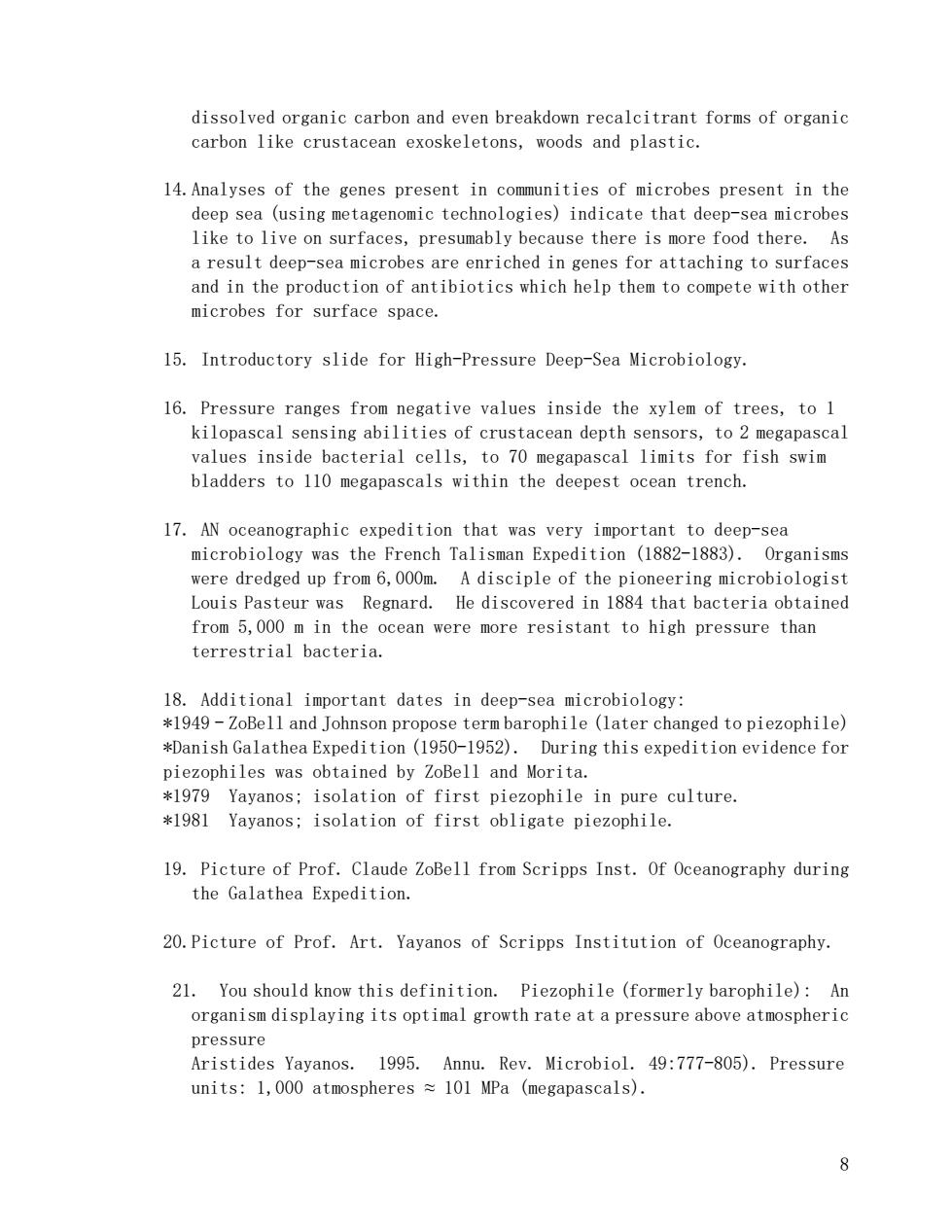正在加载图片...

dissolved organic carbon and even breakdown recalcitrant forms of organic carbon like crustacean exoskeletons,woods and plastic. 14.Analyses of the genes present in communities of microbes present in the deep sea (using metagenomic technologies)indicate that deep-sea microbes like to live on surfaces,presumably because there is more food there.As a result deep-sea microbes are enriched in genes for attaching to surfaces and in the production of antibiotics which help them to compete with other microbes for surface space. 15.Introductory slide for High-Pressure Deep-Sea Microbiology. 16.Pressure ranges from negative values inside the xylem of trees,to 1 kilopascal sensing abilities of crustacean depth sensors,to 2 megapascal values inside bacterial cells,to 70 megapascal limits for fish swim bladders to 110 megapascals within the deepest ocean trench. 17.AN oceanographic expedition that was very important to deep-sea microbiology was the French Talisman Expedition (1882-1883).Organisms were dredged up from 6,000m.A disciple of the pioneering microbiologist Louis Pasteur was Regnard.He discovered in 1884 that bacteria obtained from 5,000 m in the ocean were more resistant to high pressure than terrestrial bacteria. 18.Additional important dates in deep-sea microbiology: *1949-ZoBell and Johnson propose term barophile (later changed to piezophile) *Danish Galathea Expedition(1950-1952).During this expedition evidence for piezophiles was obtained by ZoBell and Morita. *1979 Yayanos;isolation of first piezophile in pure culture. *1981 Yayanos;isolation of first obligate piezophile. 19.Picture of Prof.Claude ZoBell from Scripps Inst.Of Oceanography during the Galathea Expedition. 20.Picture of Prof.Art.Yayanos of Scripps Institution of Oceanography. 21.You should know this definition.Piezophile (formerly barophile):An organism displaying its optimal growth rate at a pressure above atmospheric pressure Aristides Yayanos.1995.Annu.Rev.Microbiol.49:777-805).Pressure units:1,000 atmospheres 101 MPa (megapascals). P8 dissolved organic carbon and even breakdown recalcitrant forms of organic carbon like crustacean exoskeletons, woods and plastic. 14.Analyses of the genes present in communities of microbes present in the deep sea (using metagenomic technologies) indicate that deep-sea microbes like to live on surfaces, presumably because there is more food there. As a result deep-sea microbes are enriched in genes for attaching to surfaces and in the production of antibiotics which help them to compete with other microbes for surface space. 15. Introductory slide for High-Pressure Deep-Sea Microbiology. 16. Pressure ranges from negative values inside the xylem of trees, to 1 kilopascal sensing abilities of crustacean depth sensors, to 2 megapascal values inside bacterial cells, to 70 megapascal limits for fish swim bladders to 110 megapascals within the deepest ocean trench. 17. AN oceanographic expedition that was very important to deep-sea microbiology was the French Talisman Expedition (1882-1883). Organisms were dredged up from 6,000m. A disciple of the pioneering microbiologist Louis Pasteur was Regnard. He discovered in 1884 that bacteria obtained from 5,000 m in the ocean were more resistant to high pressure than terrestrial bacteria. 18. Additional important dates in deep-sea microbiology: *1949 - ZoBell and Johnson propose term barophile (later changed to piezophile) *Danish Galathea Expedition (1950-1952). During this expedition evidence for piezophiles was obtained by ZoBell and Morita. *1979 Yayanos; isolation of first piezophile in pure culture. *1981 Yayanos; isolation of first obligate piezophile. 19. Picture of Prof. Claude ZoBell from Scripps Inst. Of Oceanography during the Galathea Expedition. 20.Picture of Prof. Art. Yayanos of Scripps Institution of Oceanography. 21. You should know this definition. Piezophile (formerly barophile): An organism displaying its optimal growth rate at a pressure above atmospheric pressure Aristides Yayanos. 1995. Annu. Rev. Microbiol. 49:777-805). Pressure units: 1,000 atmospheres ≈ 101 MPa (megapascals)